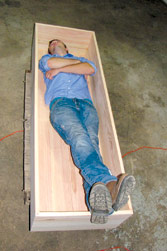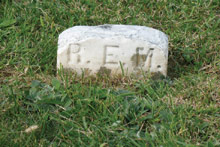Kim Zorn keeps death at her doorstep—and all in the family. She runs the Green Casket Co., whose workshop in Candler produces biodegradable coffins. The business also draws on the talents of her carpenter husband, Ron Prior, their four big sons, and furniture maker Braun Meriwether.

“We test everything,” Zorn reveals with a laugh. “We put [our sons] in the caskets and make sure we can carry them.” Even the family’s black cat gets in on the action, curling up in a sample pet casket at home.
“Our kids want us to make the ‘toe-pincher’ caskets—the tombstone-shaped ones you see in old Westerns. They say they’re more cool,” she explains.
Zorn’s dedication and sense of humor stem, in part, from her many years as a hospice nurse. “I work with death all the time,” she notes. “It’s kind of nice to do something light.”
Light?
In modern times, Zorn responds, we’ve become alienated from the whole death experience. In years past, the dead were kept and viewed at home prior to burial nearby, often on the family land. It was a more intimate and natural process. But modern American burial practices tend more toward funeral homes, embalming, concrete-lined graves and nonbiodegradable caskets. “We need to get back to the way it was,” argues Zorn.
Her company is part of a larger green-burial movement that seeks to return to more environmentally friendly practices. Toxic chemicals used in embalming can eventually find their way into ground water, and even cremation may release toxins into the air, she notes. In green burial, “It’s all about letting the body [and casket] decompose naturally,” Zorn explains.
Her caskets feature handles made of handcrafted, locally grown hemp rope. Inside the box, all-natural muslin liners are filled with pine shavings, a byproduct of the building process. The exteriors are usually locally grown and harvested pine—typically unfinished, though the company sometimes uses nontoxic stains and paints made by another local firm, Earthpaint. “I had a man try to sell me pine from China, but that would defeat the purpose,” notes Zorn. “We want people to buy local and to bury locally.”
“If it’s not a local wood, we’re not going to use it,” adds Prior.
The company can also use reclaimed wood, says Meriwether, whose background includes refinishing antique furniture. But while locust (which is common in Western North Carolina) may be good for fence posts because it doesn’t rot, that makes it bad for green burial, he explains. Green burial can also have a conservation element, helping preserve privately owned land in its natural state.

Coffins aside, Zorn stresses that planning a funeral doesn’t have to be a dark experience. Before the burial, her caskets can be taken home and decorated (using nontoxic materials, of course). Loved ones, she notes, can sign a casket much as we sign someone’s cast when they’ve broken a bone. The casket “becomes like part of the family,” says Zorn, who’s obviously at ease with a topic that leaves many Americans queasy.
So is Groce Funeral Home owner Dale Groce, who says he’s not sure he’d call green burial a trend, exactly. “It’s just a return to what we used to do”—and sometimes still do. During his many years in the business, Groce says he’s done many simple burials on family farms. “But we didn’t call it a ‘green’ burial; I just didn’t think of it that way,” he admits.
Concrete liners aren’t required on private property; nor is embalming, notes Groce. “By the laws in North Carolina and Buncombe County, burial can be anywhere on private property as long as it doesn’t intrude on a water source, such as an underground spring or well.” The liners, he says, are primarily a maintenance issue: Without them, graves tend to sink.
Another challenge is finding cemeteries that even allow green-burial practices such as dispensing with the liner. “The options are limited,” says Groce, though he mentions one in South Carolina that goes further still, permitting burials in only a shroud.
Zorn, meanwhile, accentuates the positive, noting that her company has a custom casket that’s just waiting for the right situation. “Just the other day, we had someone who wanted to bury their Saint Bernard. Braun built it, but the customer decided on cremation. So now we have one lollapalooza of a casket to sell.”
Send your environmental news to mvwilliams@mountainx.com.



That is such a great idea. The earth can’t support all of the typical burials. It is inevitable that at some point you will be dug up for a parking lot or a walmart. Why not return your body to the earth? I am so proud of this woman.